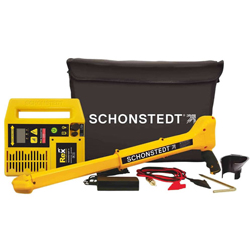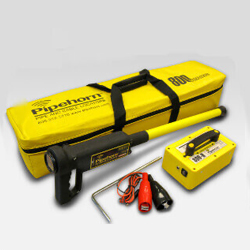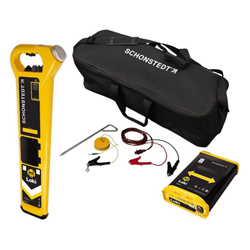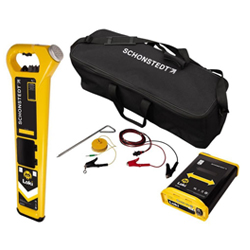
This multi-frequency pipe locator by Schonstedt is a great choice for the working professional, because it has the following features:
- The transmitter is less than 2 inches thick and weighs less than 4 pounds.
- The entire unit fits easily into a custom storage bag.
- The receiver and transmitter together weigh under 7 pounds for an ultralight design.
- The receiver can retract for easier carrying.
- Capable of 512 Hz, 33 kHz, and 82 kHz frequency detection.
- Capable of 50/60 Hz passive and 512 Hz sonde detection.
- The transmitter comes with rechargeable batteries.
This unit is built for utility professionals in the water, sewer, gas, electric, and telecommunication industries.

With the ability to detect frequencies of up to 480 kHz, this pipe locator can find utility lines that are buried down to 18 feet deep (depending on the type of connection, the condition of the soil, and how well it can conduct the signal). It also has a fast-response signal strength and a sharp audio tone that allows for precision pinpointing. And with a watertight reinforced receiver wand, it's incredibly durable. The transmitter has a high-impact ABS housing that’s bright yellow, so it’s easier to see.

This utility locator is perfect for “sweeping” a large area to find buried assets quickly and easily. The Schonstedt Loki has a number of features that support the quick and easy detection of underground utility lines. Some of them include but may not be limited to:
- The 512 Hz frequency can be used to trace metallic pipes, while the 82 kHz frequency can find hard-to-locate jointed pipes.
- The simple mode selection matches the device to the signal type you need to locate.
- The Sonde Mode can find a signal being transmitted by a compatible sonde.
- The Transmitter Mode can find transmitter signals being imposed on buried utilities.
- The Power Mode can find the electromagnetic fields being generated by loaded power cables.
- The Dual Mode simultaneously searches for and identifies transmitter and power signals for quicker sweeps.
- The ShallowAlert feature will warn you of the possible presence of shallow cables and utility lines in every mode.
- The NoiseProtect feature allows you to use the device in areas that are electrically noisy.
Be sure to pick yours up at Engineer Supply today!

With a receiver that weighs 4.9 pounds and a transmitter that weighs 4.0 pounds, this unit is a lightweight tool that’s perfect for finding pipes, cables, and underground utility lines in large areas. It also has a IP54 rating, which makes it resistant to water and dust. The transmitter has a built-in speaker that generates an audio signal, which can be heard over road traffic. The receiver also has a detachable speaker that can double as an earpiece.
If you’re looking for an underground utility locator to help you find buried pipes and cables, be sure to look at what we have at Engineer Supply.